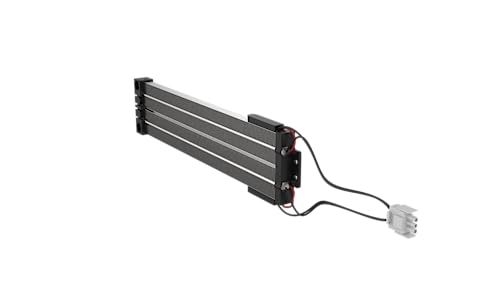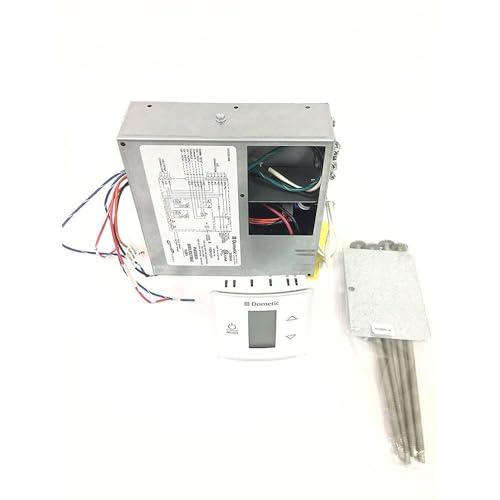The following guide reviews top options for a strip heater with thermostat setup, combining heat strips, thermostats, and controllers ideal for RVs, garages, and specialty applications. The selected products represent plug‑in heat strips, RV thermostats that support heat strip control, smart thermostats for electric heaters, and dual‑probe controllers for DIY setups. Use the summary table to compare core functions at a glance.
| Product | Type | Key Feature | Best For |
|---|---|---|---|
| Furrion Chill AC Heat Strip | AC Heat Strip Kit | Easy Install, Energy Efficient | RV AC supplemental heat |
| Dometic CT Single Zone Thermostat | RV Thermostat/Control Kit | Cool/Furnace/Heat Strip Modes | OEM RV climate control |
| SPORDA RV Single Zone Thermostat | Digital Wall Thermostat | Capacitive Touch, Heat Strip Compatible | Replacement RV thermostats |
| meross Smart Thermostat | Smart High‑Voltage Thermostat | Wi‑Fi, HomeKit/Alexa/Google | Smart control for electric heaters |
| Pymeter Dual Probe Temperature Controller | Digital Dual Outlet Controller | Two Independent Outlets, Alarms | DIY zones, fermentation, reptile, or heat strips |
Content Navigation
- Furrion Chill AC Heat Strip
- Dometic CT Single Zone Thermostat
- SPORDA RV Single Zone Thermostat
- meross Smart Thermostat For Electric Heaters
- Pymeter Dual Probe Temperature Controller
- Buying Guide: Choosing A Strip Heater With Thermostat
- 1. Application And Heat Output
- 2. Thermostat Compatibility And Control Modes
- 3. Electrical Ratings And Safety
- 4. Installation Complexity
- 5. Control Features And Automation
- 6. Environment And Mounting
- 7. Energy Use And Efficiency
- 8. Load Switching And Ancillary Hardware
- 9. Sensor Types And Placement
- 10. Compatibility With Existing Systems
Furrion Chill AC Heat Strip

The Furrion Chill AC Heat Strip is designed to integrate with RV air conditioners to provide supplemental heating. It is described as lightweight and intended for quick installation by removing the AC cover and plugging in the strip. The product emphasizes providing heat on cold mornings and nights without engaging the furnace.
- Primary Use: Supplemental heating for RV cabins when temperatures are just below comfortable.
- Installation: Plug‑in style intended for in‑shroud placement—minimal tools required.
- Efficiency: Promoted as a way to conserve propane by using electric heat for modest warmth needs.
- Performance Notes: Best suited for short‑term chill removal rather than primary heating in freezing conditions.
Dometic CT Single Zone Thermostat

The Dometic CT single zone thermostat is an OEM‑style control designed to operate cooling, furnace, and heat strip modes within RV climate systems. It features a digital display and an interface intended for precise, user‑friendly temperature control.
- Multi‑Functionality: Controls cooling, furnace, and heat strip operations from one controller.
- Accuracy: Advertised as providing advanced temperature regulation to minimize fluctuations.
- User Interface: Digital display and straightforward configuration aimed at in‑vehicle installation.
- Compatibility: Typical replacement for single‑zone RV HVAC systems that require a heat strip control input.
SPORDA RV Single Zone Thermostat

Call 888-896-7031 for Free Local HVAC Quotes – Compare and Save Today!
The SPORDA single zone wall thermostat is marketed as a direct replacement for many RV single‑zone thermostats. It combines a capacitive touch interface with support for cooling, heat pump, and heat strip control. The unit is wall‑mountable and emphasizes precise temperature control.
- Design: Modern capacitive touch controls and backlit display for visibility.
- Compatibility: Listed as compatible with a range of single‑zone RV units and heat strip configurations.
- Modes: Supports automatic and manual operation modes for flexible control.
- Installation: Intended as a direct swap for existing single‑zone thermostats; wiring verification recommended.
meross Smart Thermostat For Electric Heaters

The meross smart thermostat is engineered for high‑voltage electric baseboard, convector, and fan‑forced heaters. It provides Wi‑Fi connectivity and smart home integrations with Apple HomeKit, Alexa, and Google Home. The thermostat supports programmable schedules and remote control via apps and voice.
- High Voltage Support: Rated for 120–240V systems up to specified amperage limits; suitable for many electric heating elements.
- Smart Integration: Works with major voice assistants and smart hubs for automated control.
- Installation: Requires a multi‑wire connection (four or more wires) in the electrical box—installer familiarity with high‑voltage wiring is advised.
- Use Cases: When pairing a hardwired strip or baseboard heater with a smart control is desired.
Pymeter Dual Probe Temperature Controller

The Pymeter digital temperature controller is a dual‑outlet unit with two waterproof sensors. Each outlet can be configured independently to switch heating or cooling devices on and off at setpoints. The device features alarms and independent temp control for two zones, which can be leveraged to manage heat strips in DIY installations.
- Dual Control: Two independently controlled outlets allow separate setpoints and hysteresis settings.
- Safety Features: High/low temperature alarms and temperature difference alarms to protect targets.
- Applications: Suitable for fermentation, reptile enclosures, dual‑zone heating, or controlling electric heat strips with appropriate relays or contactors.
- Power Consideration: Rated at 10A/1200W per outlet—verify that the connected heat strip amperage does not exceed limits or use external switching hardware.
Buying Guide: Choosing A Strip Heater With Thermostat
Selecting the right combination of strip heater and thermostat depends on application, power requirements, and integration needs. This guide highlights the key factors to compare before purchase.
Call 888-896-7031 for Free Local HVAC Quotes – Compare and Save Today!
1. Application And Heat Output
Identify the intended use: RV supplemental heat, workshop space, fermentation, or animal enclosures. Match the strip heater’s output to the space. For RVs, AC heat strips are designed to work inside the AC shroud. For permanent room heating, baseboard or ceiling elements require proper mounting and wiring.
2. Thermostat Compatibility And Control Modes
Ensure the thermostat supports the heater type. RV thermostats often include a specific heat strip mode to enable switching in the HVAC control logic. Smart thermostats typically target high‑voltage loads but require compatible wiring and load ratings. Dual controllers offer flexible setpoints for multi‑zone control but may need relays for higher currents.
3. Electrical Ratings And Safety
Confirm voltage and amperage ratings. Many DIY controllers are rated for 10A–15A; larger heat strips or baseboards may draw more and require contactors or hard‑wired thermostats. Verify overheat protection, proper grounding, and adherence to local electrical codes. For RV installations, ensure the product is approved for mobile use if required.
4. Installation Complexity
Plug‑in heat strips are often the easiest to install. Hard‑wired thermostats and high‑voltage smart controllers require electrical knowledge or a licensed electrician. Wall thermostat replacements typically follow existing wiring but confirm terminal compatibility before purchase.
5. Control Features And Automation
Decide whether you need simple mechanical or digital thermostats, programmable schedules, remote Wi‑Fi access, or smart home integration. Smart thermostats offer convenience and scheduling but may impose wiring and load constraints. Dual‑probe controllers provide redundancy and multi‑zone management without cloud dependence.
6. Environment And Mounting
Consider environmental conditions such as vibration (RVs), humidity, and temperature ranges. Some heat strips are designed specifically for in‑shroud AC placement; others need clearance and mounting hardware. Ensure the chosen thermostat’s sensor placement accurately reflects the area you want to control.
7. Energy Use And Efficiency
Electric heat strips provide direct warmth but can be energy intensive compared with furnaces using other fuels. Use thermostats with programmable setbacks, smart integrations, or proportional control methods to reduce runtime and improve efficiency during mild conditions.
8. Load Switching And Ancillary Hardware
If the controller cannot handle the heater’s current, plan for a relay, contactor, or an SSR suitable for the load and environment. For AC heat strips in HVAC systems, follow manufacturer guidance for how the thermostat signals the strip and furnace. For DIY setups, add fusing and temperature alarms for protection.
9. Sensor Types And Placement
Thermostats can use internal sensors, remote probes, or dual probes. Placement affects control accuracy—mount sensors away from direct heat radiation or drafts. Dual sensors enable separate zone control or averaged readings for more stable regulation.
10. Compatibility With Existing Systems
For RV retrofits, confirm the thermostat is compatible with the brand and model of your existing HVAC or heat strip wiring. OEM controllers such as Dometic often have known compatibility lists. Third‑party replacements should document supported systems and wiring diagrams.
When evaluating products, cross‑check manufacturer documentation for wiring diagrams, power ratings, and intended installation contexts. If uncertain about electrical compatibility or load switching, consult a qualified technician to verify safe installation and compliance with local codes.
Tips for Getting the Best HVAC Prices
- Prioritize Quality Over Cost
The most critical factor in any HVAC project is the quality of the installation. Don’t compromise on contractor expertise just to save money. - Check for Rebates
Always research current rebates and incentives — they can significantly reduce your overall cost. - Compare Multiple Quotes
Request at least three estimates before making your choice. You can click here to get three free quotes from local professionals. These quotes include available rebates and tax credits and automatically exclude unqualified contractors. - Negotiate Smartly
Once you've chosen a contractor, use the proven strategies from our guide — How Homeowners Can Negotiate with HVAC Dealers — to get the best possible final price.
